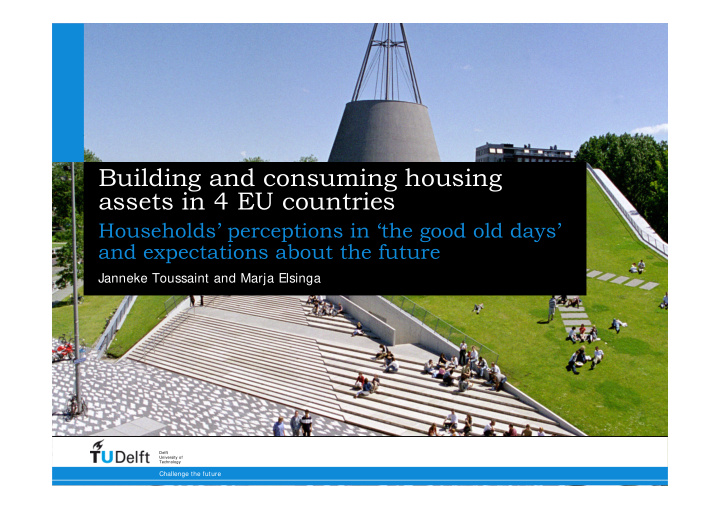



Building and consuming housing assets in 4 EU countries Households’ perceptions in ‘the good old days’ and expectations about the future Janneke Toussaint and Marja Elsinga Delft University of Technology Challenge the future
Introduction • Financial insecurity • Growth of owner-occupation • More debts – more risks • More housing wealth – more security • Life cycle theories • Housing assets are different (Levin 1998) • Why do households build housing assets and how do they plan to consume them in times of financial hardship? Building and consuming housing assets in 4 EU countries | xx 2
100% 90% 80% 70% Social rental 60% 50% Private rental 40% Owner-occupation 30% 20% 10% 0% y s y K r n d U a a n g m a n l r u r e e H h G t e N Figure 2 Housing tenure structure Financial insecurity At risk of poverty rate Everyone is at risk of after social transfer poverty at some time (Eurostat) in their life ’ s (% agrees) (Eurobarometer) Germany 12 64 Hungary 13 74 The Netherlands 11 50 United Kingdom 19 65 Building and consuming housing assets in 4 EU countries | xx 3
Germany (Tegeder & Helbrecht 2007) Building housing assets • Private rental sector attractive as long as unsettled • Buying once in a lifetime • Mortgage repayment as soon as possible Conditions • Insecurity labour market and welfare restructuring • Housing assets not taken in account for state benefits Owner-occupation and financial hardship • Reduced housing expenses • ‘Pension in stone’ Building and consuming housing assets in 4 EU countries | xx 4
Hungary (Hegedüs & Teller 2007) Building housing assets • Buying necessary starting point for the young • Avoidance insecure and stigmatised rental sector • Housing assets part of family’s safety-net strategy Conditions • Insecurity about maintenance costs, house prices, incomes and no reliance on state welfare provision • Pass on housing wealth to children Owner-occupation and financial hardship • Support from heirs – ‘life annuity schemes’ • Last resort: downsizing (not always good solution) Building and consuming housing assets in 4 EU countries | xx 5
The Netherlands (Toussaint & Elsinga 2007) Building housing assets • Better to buy if you can afford • House price increases • Difficult access social rental sector Conditions • Reliance on welfare state and labour market Owner-occupation and financial hardship • Housing assets are nest-egg for emergencies • Self-employed - pension Building and consuming housing assets in 4 EU countries | xx 6
United Kingdom (Quilgars & Jones 2007) Building housing assets • One day the property will be theirs • Investment, gains from market • Rental sector no acceptable alternative Conditions • Vague notion of risks, but plenty of opportunities labour market; no reliance on state welfare provision • Tenants: ‘Why build housing assets if I have to consume them at old age’ • Pass housing wealth on to children Owner-occupation and financial hardship • Retirement • Downsizing Building and consuming housing assets in 4 EU countries | xx 7
‘The good old days’ Why build housing assets? • Avoid insecure rental sector (UK, Hung) • Part of private safety net planning (Hung) • House price increases (Neth, UK) • Profit from incentives government (Hung, Neth) • Not taken into account for benefits (UK, Germ) Why not consume housing assets? • State welfare provision (Neth, Germ) • Many other strategies with owner-occupation • Bequest motives • Illiquidity: selling- heart and soul in the ‘home’ • MEW: prosperity; distrust reverse mortgages • Hold on to assets in times of financial hardship Building and consuming housing assets in 4 EU countries | xx 8
Now: financial insecurity- unemployment, pensions under pressure Will households consume their housing assets? Owner-occupation, especially meaningful if no state welfare provision 1. Reduced housing expenses 2. Other strategies: sublet, or to get support from heirs 3. Last resort: selling However, if many people want to sell, housing market stagnates - Then, mortgage equity withdrawal better option?! Different histories, norms and customs: Germans: ‘pension in stone’ & aversion towards mortgage debts Hungarians: make their own contracts based on inheritance Dutch: borrow according fiscal arrangements British: did go through the ‘learning curve’ of MEW, but wish to have the cake and eat it Building and consuming housing assets in 4 EU countries | xx 9
References M Elsinga, P De Decker, N Teller, J Toussaint (eds). Home ownership beyond asset and security. Perceptions of housing related security and insecurity in eight European countries. , Amsterdam: IOS Press: • Hegedüs J, Teller N. Chapter 6. Hungary: Escape into home ownership . • Quilgars D, Jones A. Chapter 10. United Kingdom: Safe as houses? • Tegeder G, Helbrecht I. Chapter 5. Germany: Home ownership, a Janus- faced advantage in time of welfare restructuring. • Toussaint J, Elsinga M. Chapter 7. The Netherlands: Positive prospects and equity galore. Levin L. 1998. Are assets fungible? Testing the behavioral theory of life savings. Journal of economic behavior and organization 36: 59-83 Building and consuming housing assets in 4 EU countries | xx 10
Recommend
More recommend